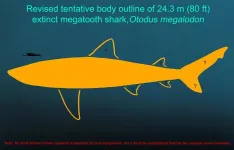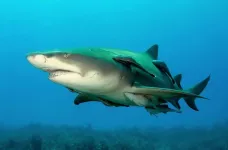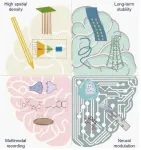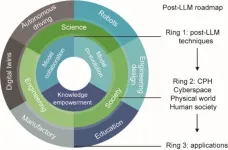(Press-News.org) Politicians learned this lesson a long time ago: a well-placed joke is a valuable tool for capturing public attention and building trust. Scientists, however, are much more reluctant to use humor when engaging in science communication. They may fear that a lighthearted approach could make them seem less authoritative and, consequently, make scientific findings appear less credible.
The good news, however, is that science itself seems to contradict this assumption. A new study led by Alexandra Lynn Frank, a doctoral student at the Grady College of Mass Communication at the University of Georgia, has found that, in the communication of scientific content, humor—by eliciting mirth in the audience—“can both have positive impacts on the likeability of a communicator, as well as enhancing perceptions that the message is an appropriate and legitimate source of scientific information.”
Frank and her colleagues’ study adds to the growing body of research that has investigated the use of humor (such as stand-up comedy) in science communication in recent years. It examines humor “in the context of social media posts from scientists.”
“Our study aimed to bridge this gap by enhancing our understanding of how individuals react to anthropomorphism and satire while providing practical insights for scientists and science communicators,” Frank explains.
The research focused on artificial intelligence-related content, presented through cartoons posted on Twitter/X by a fictional scientist, Dr. Jamie Devon. The type of humor used fell into three categories: satire (a mild, Horatian type), anthropomorphism (using animals or objects behaving like humans), or a combination of the two.
The study employed an online survey with an embedded experiment (participants were aware they were taking a survey but not that they were part of an experiment). To ensure the representativeness of the 2,212 participants, they were selected using quota sampling aligned with U.S. Census data.
Participants were shown one of eight versions of a fictional Twitter/X conversation initiated by Dr. Devon. The tweet included a cartoon about artificial intelligence (AI), and the humor element was varied across four conditions: no humor (control), anthropomorphism, satire, and a combination of both. After viewing the content, participants reported how much mirth (i.e., perceived humor) they experienced, how likable they found the scientist and evaluated the legitimacy of the content as an appropriate form of science communication.
“Politicians, entertainers, and advertisers often use humor because people tend to like and connect with people who can make them laugh. When people find something funny, they’re usually less likely to argue with or reject the message or the person delivering it. Our research supports this idea. We found that humor can aid scientists’ communication efforts, but only if people think they’re funny,” Frank explains.
This means that humor must be effective and genuinely elicit mirth from the audience; otherwise, it could have the opposite effect. “However, it is important to note that recent research conducted by my coauthors indicates that harsh forms of satire can be perceived as aggressive, which may undermine the credibility of the source of scientific information.”
Sarcasm or aggressively targeting someone, for example, is highly discouraged. This is why studies like Frank and her colleagues’ work are important: “Our research aims to provide valuable insights to aid these professionals in developing public communication strategies,” Frank explains, concluding: “When used responsibly, humor is a powerful tool that can humanize scientists and create meaningful connections with the public on social media. By leveraging humor, scientists can simplify complex concepts, making them more relatable and easier to understand. This approach not only fosters goodwill but also has the potential to dispel misinformation in a friendly manner. Moreover, humor can spark curiosity, motivating people to seek out additional information on important scientific topics.”
Frank and colleagues' work was supported by the NationalScience Foundation under Grant DRL-1906864. Any opinions, findings, and conclusions or recommendations expressed in this work are those of the author(s) and do not necessarily reflect the views of the National Science Foundation.
END
Can a joke make science more trustworthy?
According to a new study published in JCOM, an appropriate use of humor can make science communication more effective
2025-03-10
ELSE PRESS RELEASES FROM THIS DATE:
Hiring strategies
2025-03-10
Krapivsky drew inspiration from the famous “secretary problem” or “optimal marriage problem”. In one of its many versions, a princess must choose her future husband from a pool of 100 candidates at a grand reception. However, strict rules apply: she may meet only one suitor at a time and has limited time to get to know him. At the end of each encounter, she must decide immediately whether to accept or reject the suitor. She cannot revisit previous candidates, nor can she ask any of them to wait while she considers others. How can the princess hope to make the best choice?
The secret lies in a number: 37, to be precise (raise your hand if you ...
Growing consumption of the American eel may lead to it being critically endangered like its European counterpart
2025-03-10
High demand for eel combined with decline in stock have resulted in soaring prices for this food item, which in many cultures, is considered a delicacy. This has fuelled a concern globally as the prized food item is now being illegally traded from Europe to Asia.
Current research has focused on the critically endangered Anguilla anguilla, commonly known as the European eel. While its export outside the European Union is tightly regulated, large quantities of A. anguilla juveniles continue to be smuggled ...
KIST develops high-performance sensor based on two-dimensional semiconductor
2025-03-10
Next-generation imaging technology is rapidly expanding beyond smartphones into intelligent devices, robotics, extended reality (XR) devices, healthcare, CCTV, and various other industries. At the core of these technological advances are highly efficient, ultra-compact image sensors that convert light signals into electrical signals. Image sensors capture and process visual information from objects and environments, enabling precise reconstruction of their shape, size, and spatial position.
Currently, commercial image sensors are primarily based on silicon semiconductors. ...
New study links sleep debt and night shifts to increased infection risk among nurses
2025-03-10
A new study examining the effects of sleep patterns and shift work on the immune system has found that sleep debt and night shifts increase the risk of several common infections in nurses.
Modern society relies on shift work, which requires employees to work outside of traditional hours. While essential in sectors such as healthcare, growing evidence suggests that these work patterns may negatively impact worker’s health.
This study, which analysed self-reported data from 1,335 Norwegian nurses, found that shift work – particularly night shifts – was associated with a higher risk of several infections, including the ...
Megalodon’s body size and form uncover why certain aquatic vertebrates can achieve gigantism
2025-03-09
CHICAGO — A new scientific study provides many new insights into the biology of the prehistoric gigantic shark, Megalodon or megatooth shark, which lived nearly worldwide 15-3.6 million years ago. Paleobiology professor Kenshu Shimada of DePaul University led the study along with 28 other shark, fossil, and vertebrate anatomy experts around the globe. Findings from the study will be published in the journal “Palaeontologia Electronica.”
Formally called Otodus megalodon, it is primarily known only from its serrated teeth, vertebrae, ...
A longer, sleeker super predator: Megalodon’s true form
2025-03-09
The megalodon has long been imagined as an enormous great white shark, but new research suggests that perception is all wrong. The study finds the prehistoric hunter had a much longer body—closer in shape to a lemon shark or even a large whale.
The study team, which included researchers from University of California, Riverside and across the globe, used a novel approach to estimate the shark’s total body length, moving beyond traditional methods that rely primarily on tooth size. By examining megalodon’s vertebral column and comparing ...
Walking, moving more may lower risk of cardiovascular death for women with cancer history
2025-03-09
Research Highlights:
Increased physical activity including taking more daily steps was linked to a lower risk of death from cardiovascular disease among postmenopausal women with a history of cancer.
The study found that engaging in one hour per day of moderate to vigorous physical activity reduced participants’ risk of death from any cause by 40% and risk of death from cardiovascular disease by 60%.
Each additional 2,500 steps per day for a participant was associated with a 34% reduction in risk of death from cardiovascular disease.
Note: The study featured in this news release is a research abstract. Abstracts presented ...
Intracortical neural interfaces: Advancing technologies for freely moving animals
2025-03-09
A recent study published in Engineering delves into the latest progress in intracortical neural interface technologies for freely moving animals. These interfaces, which establish a connection between the nervous system and external devices, have the potential to revolutionize neuroscience research and clinical medicine.
The researchers, led by Xinxia Cai, Zhaojie Xu and Yirong Wu, analyzed four key technological directions for ideal implantable neural interface devices: higher spatial density, improved biocompatibility, enhanced multimodal detection of electrical/neurotransmitter signals, and more effective neural modulation.
In terms of high spatial density, microelectrode ...
Post-LLM era: New horizons for AI with knowledge, collaboration, and co-evolution
2025-03-08
A recent paper published in the journal Engineering delves into the future of artificial intelligence (AI) beyond large language models (LLMs). LLMs have made remarkable progress in multimodal tasks, yet they face limitations such as outdated information, hallucinations, inefficiency, and a lack of interpretability. To address these issues, researchers explore three key directions: knowledge empowerment, model collaboration, and model co-evolution.
Knowledge empowerment aims to integrate external knowledge into LLMs. This can be achieved through various methods, including integrating knowledge ...
“Sloshing” from celestial collisions solves mystery of how galactic clusters stay hot
2025-03-08
Tokyo, Japan – The XRISM collaboration have discovered flows of hot gas in the core of the Centaurus Cluster. By comparing state-of-the-art X-ray measurements from the XRISM satellite with numerical simulations, they showed this is evidence for collisions between galaxy clusters, causing gas inside to “slosh”. This solves the longstanding mystery of how cluster cores stay hot, and sheds light on how our universe continues to evolve.
Astronomers have long envisioned how vast gravitational forces ...
LAST 30 PRESS RELEASES:
Interaction of climate change and human activity and its impact on plant diversity in Qinghai-Tibet plateau
From addressing uncertainty to national strategy: an interpretation of Professor Lim Siong Guan’s views
Clinical trials on AI language model use in digestive healthcare
Scientists improve robotic visual–inertial trajectory localization accuracy using cross-modal interaction and selection techniques
Correlation between cancer cachexia and immune-related adverse events in HCC
Human adipose tissue: a new source for functional organoids
Metro lines double as freight highways during off-peak hours, Beijing study shows
Biomedical functions and applications of nanomaterials in tumor diagnosis and treatment: perspectives from ophthalmic oncology
3D imaging unveils how passivation improves perovskite solar cell performance
Enriching framework Al sites in 8-membered rings of Cu-SSZ-39 zeolite to enhance low-temperature ammonia selective catalytic reduction performance
AI-powered RNA drug development: a new frontier in therapeutics
Decoupling the HOR enhancement on PtRu: Dynamically matching interfacial water to reaction coordinates
Sulfur isn’t poisonous when it synergistically acts with phosphine in olefins hydroformylation
URI researchers uncover molecular mechanisms behind speciation in corals
Chitin based carbon aerogel offers a cleaner way to store thermal energy
Tracing hidden sources of nitrate pollution in rapidly changing rural urban landscapes
Viruses on plastic pollution may quietly accelerate the spread of antibiotic resistance
Three UH Rainbow Babies & Children’s faculty elected to prestigious American Pediatric Society
Tunnel resilience models unveiled to aid post-earthquake recovery
Satellite communication systems: the future of 5G/6G connectivity
Space computing power networks: a new frontier for satellite technologies
Experiments advance potential of protein that makes hydrogen sulfide as a therapeutic target for Alzheimer’s disease
Examining private equity’s role in fertility care
Current Molecular Pharmacology achieves a landmark: real-time CiteScore advances to 7.2
Skeletal muscle epigenetic clocks developed using postmortem tissue from an Asian population
Estimating unemployment rates with social media data
Climate policies can backfire by eroding “green” values, study finds
Too much screen time too soon? A*STAR study links infant screen exposure to brain changes and teen anxiety
Global psychiatry mourns Professor Dan Stein, visionary who transformed mental health science across Africa and beyond
KIST develops eco-friendly palladium recovery technology to safeguard resource security
[Press-News.org] Can a joke make science more trustworthy?According to a new study published in JCOM, an appropriate use of humor can make science communication more effective








